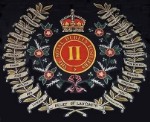"Nighttown" (the Monto)
"(The Mabbot street entrance of nighttown, before which stretches an uncobbled tramsiding set with skeleton tracks, red and green will-o'-the-wisps and danger signals. Rows of grimy houses with gaping doors. Rare lamps with faint rainbow fans. Round Rabaiotti's halted ice gondola stunted men and women squabble. They grab wafers between which are wedged lumps of coral and copper snow. Sucking, they scatter slowly, children. The swancomb of the gondola, highreared, forges on through the murk, white and blue under a lighthouse. Whistles call and answer.)"
n/ Ulysses (Gabler) 15:1-9.
The Monto was Dublin's red light district and dated back to the early nineteenth century. Named for Montgomery Street, it was situated close to the North Docks, just behind the Custom House. In Ulysses, Joyce called the Monto "Nighttown." It was not the city's first red light district as it was pre-dated by "Hell" in Southside Dublin, near Christ Church Cathedral. Hell was a notorious district of brothels, gambling houses, and taverns and was denoted by name in Rocque's famous 1756 Map of Dublin (though in tiny print). Urban renewal of the early nineteenth century by the Wide Streets Commission put Hell out of business and its trade was taken over by the Monto.
n/ Maurice Curtis, To Hell or Monto, (Dublin: History Press Ireland, 2015).
In vain efforts to improve the reputation of the Monto's streets, the municipal government relabeled the thoroughfares several times: Mecklinburgh Street became first Tyrone Street then later Railway Street; Montgomery Street became Foley Street; Mabbot Street became Corporation Street. Note that the colonial government of Gibraltar changed the name of the town's street of brothels from Serruya's Lane to New Street. To honor the author of Ulysses, in 1965 the Dublin City Council restyled Corporation Street as James Joyce Street.
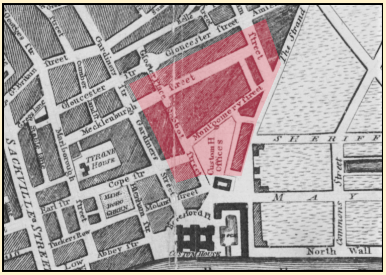
A Plan of the City of Dublin 1811, British Library
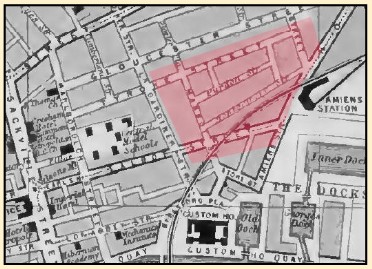
Baddeley's Guide to Ireland, 1909
Looking west from Corporation Street. Nelson's Pillar is visible in the background. This image, on the website flickr, will open in a new browser window.
"Ruinous houses, 88-93 Railway Street"
Report of the Departmental Committee appointed by the Local Government Board for Ireland to inquire into the Housing Conditions of the Working Classes in the City of Dublin, 1914, [Cd. 7273].
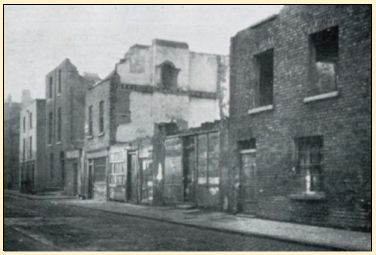
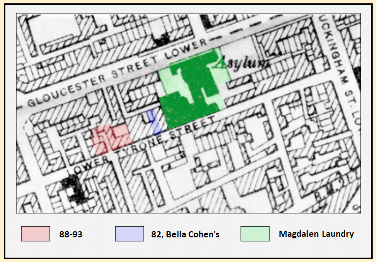
Intersection of Gloucester Place and Railway Street
Report of the Departmental Committee appointed by the Local Government Board for Ireland to inquire into the Housing Conditions of the Working Classes in the City of Dublin, 1914, [Cd. 7273].
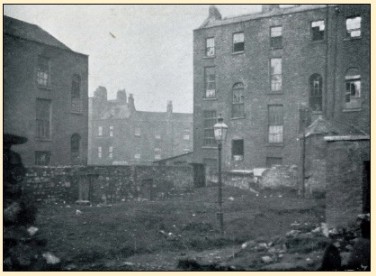
Bella Cohen's on Lower Tyrone Street
On Bloomsday, the core of the Monto was Lower Tyrone Street, formerly named Mecklenburgh Street. In the Circe episode of Ulysses, Bella Cohen's brothel is located at 82 Tyrone Street Lower. Thom's Directory for 1904 shows the property had an assessed annual, rental value of £20 and "Mrs. Cohen" the ratepayer at that address.
n/ Ulysses (Gabler) 17:2055; Thom's Official Directory of the United Kingdom (Dublin: Alex. Thom & Co. 1904), 1611.
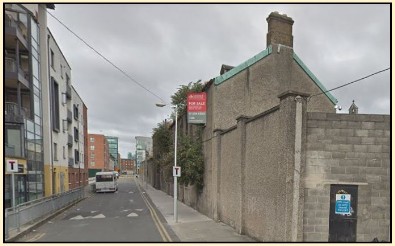
Tyrone Street in 2018, © Google Maps
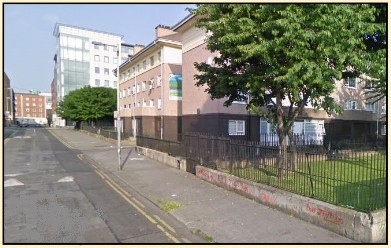
82-85 Tyrone Street in 2009, © Google Maps
The Decline and Fall of the Monto
Three factors brought an end to the infamous redlight district in 1925: Withdrawal of the British Army upon Irish independence; the Catholic Church Establishment's influence on the first Irish Free State government; the "social purity" campaign of Frank Duff's Legion of Mary.
Decline in Military PopulationIrish independence caused the brothels to lose most of their army customers. The Irish Free State, a dominion of the United Kingdom composed of the 26 southern counties of Ireland, came into being by treaty on December 22, 1922 and the British Army withdrew from the dominion. Independence sparked a civil war between the pro-treaty and anti-treaty factions of the Irish Republican Army. The pro-treaty force became the national army of the new state and at the end of the civil war totaled about 55,000 men. Demobilization reduced the army to 15,838 regulars in 1925. Further reductions brought the army down to 11,572 regulars in 1927 plus about 10,000 reservists. Prior to 1922, the British Army maintained 4,000 to 5,000 troops in Dublin and they comprised the Monto's principle market. In 1925, the Irish Army had about 3,500 troops in the city and the government planned to reduce that garrison to 2,000 (accomplished in 1927).
n/ Adrian J. English, Irish Army Orders of Battle 1923-2004 (Takoma Park, MD: Tiger Lily, 2004).
Influence of the Catholic Church EstablishmentOfficially, the Catholic Church in Ireland supported the pro-treaty separatists over the anti-treaty faction as the bishops viewed the latter as "radical" and likely to turn anti-clerical should they form the government (which turned out not to be the case). The church establishment pressured the government to run the state in conformance with Catholic doctrine. In 1937, the government of Fianna Fail (the anti-treaty separatist faction) propounded the Free State's amended constitution which added language to recognize "the special position of the Holy Catholic Apostolic and Roman Church as the guardian of the Faith professed by the great majority of the citizens." The original 1922 constitution contained no mention of the Catholic Church and simply guaranteed free profession and practice of religion to all citizens and forbade state preference or imposition of disability "on account of religious belief or religious status."
n/ Constitution of 1937, Article 44, Sec. 1, Para. 2; Constitution of 1922, Article 8.
The Legion of MaryIn 1921, 24-year old Frank Duff, son of wealthy Dublin parents and a former British civil servant then employed by the Free State, joined the Catholic St. Vincent de Paul Society and began a campaign to end prostitution in Dublin. He convinced William Cosgrave, head of the Irish government, to establish an asylum for ex-prostitutes, Sancta Maria. Duff, Fr. Michael Toher, and a group of Catholic women then formed a society which took title Sancta Maria. The Sancta Maria Society harassed prostitutes and brothel-keepers, and lobbied the municipal government to shutdown the Monto. In 1925, the organization renamed itself "The Legion of Mary." This lay Catholic organization still exists (note the humorous reference by The Dubliners in introducing "Take me up to Monto" - link to YouTube page below).
n/ Michael Pierse, "The Miracle of Monto," An Phoblacht, 5 September 2002; Donald Calloway, "Frank Duff: Founder of the Legion of May & Champion of the Rosary," May 3, 2018, www.catholicexchange.com.
On March 12, 1925 the Garda (Irish national police force) raided the Monto and made 120 arrests including 45 prostitutes, 12 pimps, and 50 customers. Further raids followed and the city moved respectable poor families into the former homes of the jailed prostitutes. Most of the arrested women accepted custody by the Legion of Mary in lieu of sentencing. The Legion placed the prostitutes into the Sancta Maria hostel and Nighttown had come to an end.
n/ Maria Luddy, Prostitution and Irish Society, 1800-1940 (Cambridge: Cambridge Univ. Press, 2007), 216.
Download from Major Tweedy's Neighborhood
To download the file, click on the document's name. The file will open in a new browser window.
Though the brothel at 82 Tyrone Street was operated by Mrs. Ellen Cohen, she does not appear as a resident on the 1901 census form for that address. Furthermore, the only Ellen Cohen recorded in the Census of Ireland, 1901, is a 14-year old girl living with her family in Ormeau, Co. Down. Note that the residents of number 82 are four young women. Pdf file of 121 kb.
In 1904, the four houses numbered 82 through 85 Tyrone Street were brothels. Mrs. Annie Mack operated the house at number 85 and she appears in both Thom's Directory and the census records for 1901. Note that the residents are 50-year old Mrs. Mack and six young women. Pdf file of 136kb.
Links to Other Websites
Note: The webpages will open in new windows.
Click on the link to go to that page of the website. Click on the icon to go to the website's home page.
Page from the website Wide and Convenient Streets. This blog by Michael Seery is about Dublin streets and some of the stories behind them. The Irish-born Seery is a faculty member of the University of Edinburgh (Chemistry) and a published, amateur historian.
Monto, The Dubliners (YouTube page)
Photographs of the Monto, c. 1920, by Paddy Coffey. The soundtrack is a live recording of "Take Me Up to Monto" sung by The Dubliners. Video created by Phil Martin.
"A ballad about the red-light district, "Take Me Up To Monto," first sung in public by the internationally-famous group the Dubliners, is widely, but incorrectly, believed to be as old as the brothel quarter it extols. In point of fact it was written in 1958, three decades after Monto had disappeared, by George Desmond Hodnett, the well-known critic of popular music for the Irish Times. In the 1950s, Hodnett was composing satirical tunes for revues at the Pike Theatre in Herbert Lane and for other Dublin theatres. "Take Me Up To Monto" was set, slightly adapted; to the air of Johnny McIldoo, and at the time of composition was not seriously intended for public performance. Ronnie Drew, a member of the Dubliners, knew of the existence of Hodnett's ballad, and when he was staging a performance by the Dubliners at the Gate Theater in 1966 included it in the programme. It was an immediate hit."
n/ Jim Irvine, Irish Folk Songs, www.irish-folk-songs.com
The link is to the first in a series of six articles by John Simpson on the Monto brothels. Published on James Joyce Online Notes.
The link is to a Google Books preview. Tadhg O'Keeffe, "Landscape and Memory: Historiography, Theory, Methodology" in Heritage, Memory and the Politics of Identity, edited by Niamh Moore and Yvonne Whelan (New York: Routledge, 2016). Click on the icon to the right for the book's page on the publisher's website.
January 15, 2018, New York Times article by Ed O'Loughlin on the Magdalen Laundry in the Monto.
